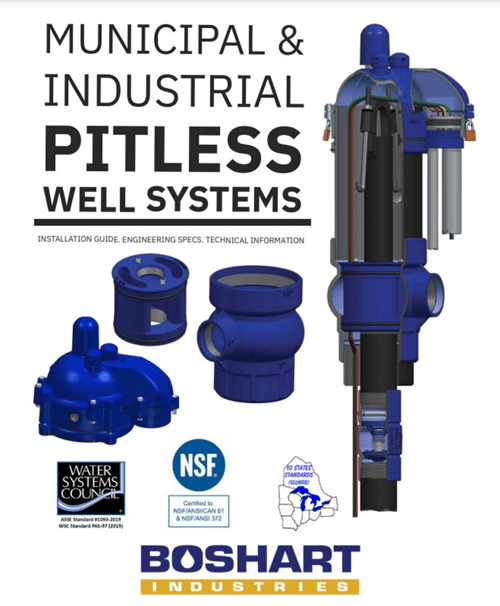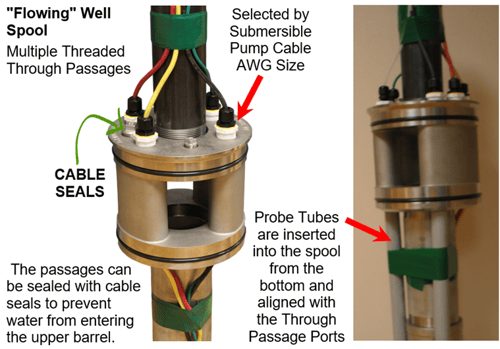- Boshart Knowledge Base
- Pitless Unit
-
Air Volume Controls
-
American Iron and Steel
-
Back Flow Prevention
-
Ball Valves
-
Bleeder Orfice
-
Brass Fittings
-
Bronze Threaded Pipe Fittings
-
Certifications
-
Check Valves
-
Chemical Compatibility
-
Chemical Composition
-
Clamps
-
Compression Coupling
-
Compression Fittings
-
Conflict Minerals
-
Constant Pressure Manifold
-
Control Box
-
CRN
-
Dielectric
-
Drain Back Valve
-
Drain Valves
-
Electrodes
-
Feet of Head
-
Filter Cartridge
-
Filter Housing
-
Filter Housings
-
Filtration
-
Flanges
-
Flare Fittings
-
Float Switch
-
Float Valve
-
Float Valves
-
Flow Controls
-
Foot Valves
-
Gallons
-
Galvanized
-
Gas
-
Gas Connector
-
Gate Valves
-
Gauges
-
Hand Pump
-
Heat Shrink
-
Hose
-
Hose Bibb
-
Hose Fittings
-
Insert Fittings
-
Iron Out
-
Jet Pumps
-
Leathers
-
Level Alarms
-
Literature
-
Malleable Iron Fittings
-
Manifolds
-
Merchant Coupling
-
Merchant Steel
-
Mounting Bracket
-
MTR
-
NPT Threads
-
NSF
-
O-Rings
-
PEX Fittings
-
PEX Valves
-
Pig Tail Syphon
-
Pipe
-
Pipe Column
-
Pipe Fittings
-
Pipe Nipples
-
Pitless
-
Pitless Adapter
-
Pitless Unit
-
Pressure Gauge
-
Pressure Snubber
-
Pressure Switch
-
Pressure Tank
-
PTFE
-
Pump Cable
-
Pump Saver
-
Push-Fit
-
PVC Fittings
-
PVC Pipe
-
Ratings
-
Relay
-
Relief Valves
-
Rope
-
Rope Hanger
-
Safety Data Sheets
-
Sewage Valves
-
Shaft Seals
-
Snifter Valve
-
SPIN-DOWN
-
Stainless Steel
-
Stainless Steel Fittings
-
Steam
-
Stop & Waste Valves
-
Sump Pump
-
Sump Pump Check Valve
-
Sweat
-
Tank Tee
-
Tank Tees
-
Technical Support
-
Thermometer
-
Thread Sealants
-
Torque Arrestor
-
Trouble Shooting
-
Tubing
-
Unit Conversions
-
Vacuum Breaker
-
Wall Hydrant
-
Warranty
-
Water Well Accessories
-
Well Cap
-
Well Caps
-
Well Packers
-
Well Point
-
Well Seal
-
Well Water Systems
-
Wire
-
Wiring
-
WROT
-
Yard Hydrants
-
Electrical Enclosures
-
Transition Couplings
-
Water Box
-
PEX Pipe
-
Combination Valve
-
Well Screen
-
Flowing Well
-
RoHS - Restriction of Hazardous Substances
-
Electrical Tape
What is the difference between a “Normal” vs. a “Flowing" Well spool used in industrial pitless adapter units?
What is the difference between a “Normal” vs. a “Flowing" Well spool used in industrial pitless adapter units?
Since 2018, Boshart has offered two spool types designed to meet the specific needs for each well installation type thus providing greater flexibility and ease of installation!
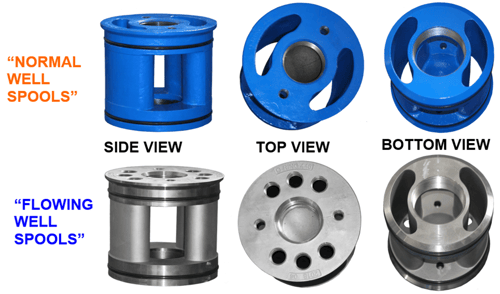
Normal Well Spools
Normal Well spool designs allows for the LARGEST possible MOON shaped through passages.
The benefits of Normal Well spools are:
❶ Allows for the installation of heavy PVC jacketed pump cable to be inserted through the spool WITHOUT the need to remove the protective jacket.
❷ Provides more room for larger diameter equipment, such as depth probes, etc., to be inserted through the spool.
❸ Allows for multiple PVC probe tubes to be inserted right through the spool. This eliminates the need to thread through the top and bottom of the spool.
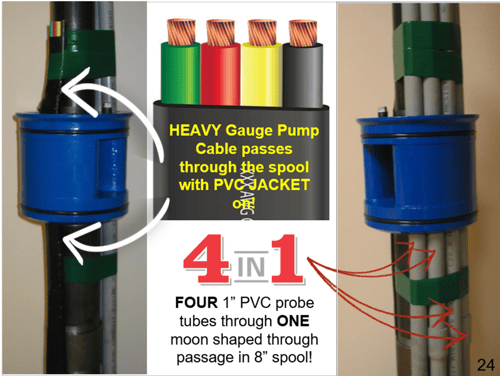
Flowing Well Spools
Flowing Well spools provide MORE & LARGER through passage tappings on 8”, 10”, and 12” spools.
The benefits of flowing well spools are:
❶ Ability to seal level monitoring or other accessory cables which allows for more installation capabilities and options.
❷ Ability to insert an inspection camera.
❸ Allows for multiple PVC probe tubes to be inserted into the bottom of the spool without the need to have custom threading on the bottom plate.
Cable Seals
Cable seals are threaded into the top plate of the spool. The submersible pump cable is then inserted through the cable seals as a single conductor.
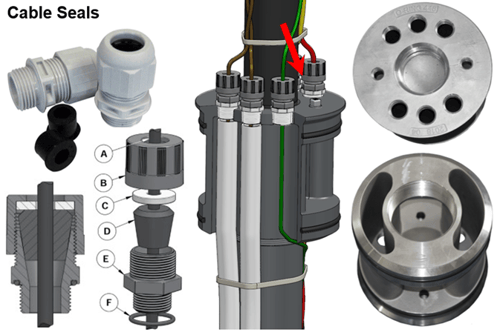
Cable seals are used in over flowing well applications and provide a water tight seal on the through passages to prevent water from entering the upper barrel chamber. They can also be used as cable restraints. 8" x 10" units require five 3/4" MPT cable seals. 10" x 12" units require five 1” MPT cable seals. 12" x 14" units require five 1" MPT cable seals. The cable diameters will be required in order to supply the proper seal. Pitless spools are tapped to accommodate cable seals as standard equipment – it is not a costly, special order feature.
See Pages 78 & 79 of the Municipal and Industrial Pitless Well Systems Installation Guide for more details:
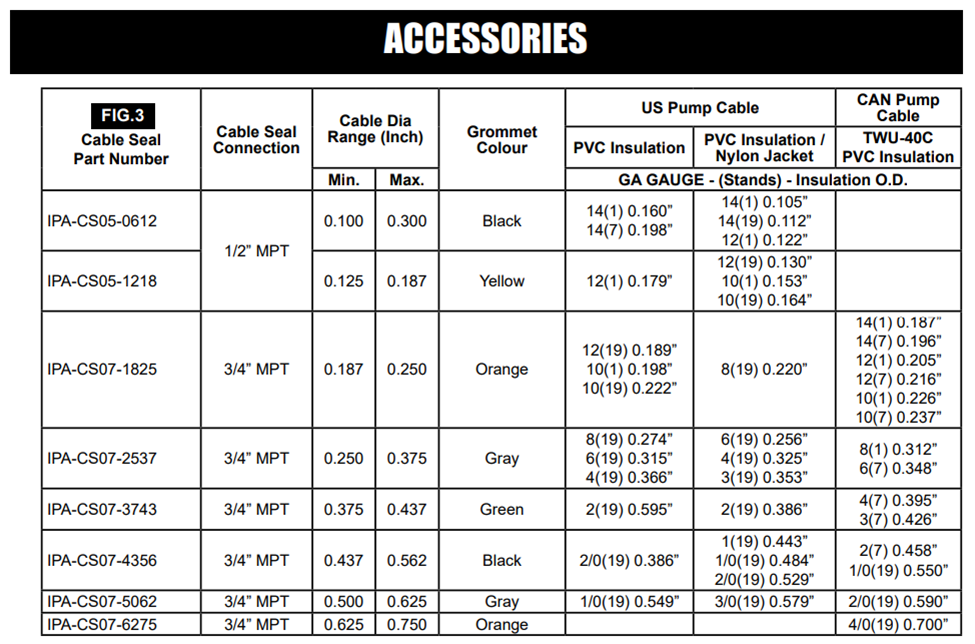
Additional Resources:
https://support.boshart.com/what-is-a-spool-type-industrial-pitless-adapter
https://support.boshart.com/how-do-i-install-a-spool-type-industrial-pitless-unit
https://support.boshart.com/do-the-spool-type-industrial-pitless-adapter-units-have-hold-down-hooks
https://support.boshart.com/how-do-i-install-a-wtcl-c-series-industrial-well-cap
Municipal and Industrial Pitless Well Systems Installation Guide:
